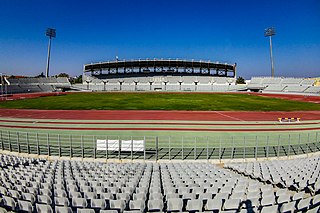
Pampeloponnisiako Stadium is a stadium located in Patras, Greece. The stadium was originally built 1981 as National Stadium of Patras.

National Road 48 is a single carriageway road in central Greece. It connects the Greek National Road 5 at Antirrio with the town Livadeia, passing through Naupactus and Delphi. The section between Antirrio and Itea is part of European route E65. The GR-48 passes through the regional units Aetolia-Acarnania, Phocis and Boeotia.

National Road 27 is a single carriageway road in central Greece. It connects the Greek National Road 3 at Bralos, south of Lamia, with the GR-48 near Itea, passing through Amfissa. It is part of the European route E65. The road passes through the regional units Phocis and Phthiotis.

The Hellenic Coast Guard is the national coast guard of Greece. Like many other coast guards, it is a paramilitary organization that can support the Hellenic Navy in wartime, but resides under separate civilian control in times of peace. The officers and the enlisted members of the Coast Guard are regarded as military personnel under Military's Penal Code. It was founded in 1919 by an Act of Parliament and the legal framework for its function was reformed in 1927. Its primary mission is the enforcement of Greek, European and International law in the maritime areas.

Georgios Kamaras Stadium is a multi-purpose stadium in Athens, Greece. It is currently used mostly for football matches and is the home stadium of Apollon Smyrnis. The stadium holds 14,200 and was built in 1948. It was used by Olympiacos for about 2 years (2002–2004) as home ground, due to the construction of their new stadium Karaiskaki. Since 2005. the stadium is named Georgios Kamaras, in honour of Georgios Kamaras, old glorious player of Apollon.
Levadia Municipal Stadium is a multi-purpose stadium in Levadia, Greece. It was built in 1952, but had its latest redevelopment in 2005. It is currently used mostly for football matches and is the home stadium of the Levadiakos since their establishment in 1961. The stadium has a capacity of 5,915.

Kapušianske Kľačany is a village and municipality in Michalovce District in the Kosice Region of eastern Slovakia. It was created in 1943 by merging the villages Kľačiany, Močiar and Ňarád, all first recorded in 1315. The current name Kapušianske Kľačany originated in 1948.

Chapel of Blessed Bronisława is a neo-Gothic Roman Catholic chapel in Kraków, Poland, erected in 1856–61 within the walls of a military citadel constructed during the Austrian Partition of Poland by the Habsburg monarchy. The chapel was meant as a replacement for the Polish 18th-century church demolished by the Austrians in 1854 during the construction of the stronghold in the Zwierzyniec district.

Migdal Afek, also Migdal Tsedek, is a national park on the southeastern edge of Rosh HaAyin, Israel. It is the site of the depopulated Palestinian village of Majdal Yaba.

The Museum of the Kalavryta Holocaust is a museum in Kalavryta, Greece dedicated to the history of the Massacre of Kalavryta in 1943. The museum contains artifacts of the German occupation of the town and documents the massacre.
Tegyra, also: Tegyrae was a town of ancient Boeotia, the site of an oracle and temple of Apollo, who was even said to have been born there. It was the site of the Battle of Tegyra in 375 BCE. It was located north of Lake Copais, above the marshes of the river Melas. Its location has been identified with sparse remains 5 km (3 mi) northeast of Orchomenus, a hill with springs at the base, the head of the Polygira tributary of the Melas. J.M. Fossey, however, placed Tegyra at modern Pyrgos, 7 km. further east, and thought the Polygira site was Homeric Aspledon.
Greek National Road 77 is a national highway on the island of Euboea, Greece. It connects Chalcis with Aidipsos via Agia Anna and Istiaia.
Greek National Road 83 is a national highway of Greece. It connects Athens with Rafina via Marathon.
Nanxing Township is a township-level division of Jingxing County, Shijiazhuang, Hebei, China.

The Spanjaardenkasteel was a castle in the city of Ghent in present-day Belgium.

Satala or Satala in Lydia was a Roman era city and Bishopric in ancient Lydia.
Lysimachia or Lysimachea or Lysimacheia (Λυσιμάχεια) was a small town in ancient Mysia, mentioned only by Pliny the Elder, in whose time it no longer existed.
Heraclea or Herakleia (Ἡράκλεια), also transliterated as Heracleia, was a town of ancient Lydia at the foot of Mount Sipylus. From this town magnets were known as Heracleus lapis.

Operation Washing was the successful destruction of the railway bridge over the Asopos River in Central Greece by four British SOE saboteurs. It took place on 21 June 1943, as part of Operation Animals.
This page is based on this
Wikipedia article Text is available under the
CC BY-SA 4.0 license; additional terms may apply.
Images, videos and audio are available under their respective licenses.













